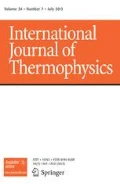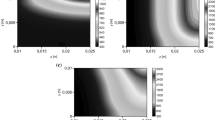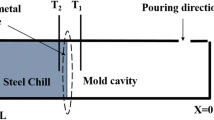Abstract
An artificial neural network (NN)-based solution of the inverse heat conduction problem of identifying the temperature-dependent volumetric heat capacity function of a solid material is presented in this paper. The inverse problem was defined according to the evaluation of the BICOND thermophysical property measurement method. The volumetric heat capacity versus temperature function is to be determined using the measured transient temperature history of a single sensor. In this study, noiseless and noisy artificial measurements were generated by the numerical solution of the corresponding direct heat conduction problem. The inverse problem was solved by back-propagation and radial basis function type neural networks applying the whole history mapping approach. The numerical tests included the comparison of two different data representations of the network inputs (i.e., temperature vs. time and time vs. temperature) and accuracy analysis of the two network types with noiseless and noisy inputs. Based on the results presented, it can be stated that feed-forward NNs are powerful tools in a non-iterative solution of function estimation inverse heat conduction problems and they are likely to be very effective in evaluation of real measured temperature histories to determine the volumetric heat capacity as an arbitrary function of temperature.













Similar content being viewed by others
Notes
The generation of the \(\rho c_{p}(T)\) functions was not completely random as that would have resulted in non-physical functions. The functions were generated point by point, and the random picking of the next point had to meet certain restrictions for the actual derivative of the function.
References
C. Yang, Int. J. Heat Mass Transf. 43, 1261 (2000)
J. Zmywaczyk, Arch. Thermodyn. 27/2, 37 (2006)
S. Zhao, B. Zhang, S. Du, X. He, Int. J. Thermophys. 30, 2021 (2009)
J. Zmywaczyk, Arch. Thermodyn. 27/3, 39 (2006)
V.T. Borukhov, V.I. Timoshpol’skii, J. Eng. Phys. Thermophys. 78, 695 (2005)
C. Huang, J. Yan, Int. J. Heat Mass Transf. 38, 3433 (1995)
J.V. Beck, B. Blackwell, C.R. St Clair Jr., Inverse Heat Conduction (Wiley, New York, 1985)
M.N. Özisik, H.R.B. Orlande, Inverse Heat Transfer: Fundamentals and Applications (Taylor & Francis, New York, 2000)
S. Vakili, M.S. Gadala, Numer. Heat Transf. B 56, 119 (2009)
N. Tian, Numer. Heat Transf. B 60, 73 (2011)
M. Raudensky, J. Horsky, J. Krejsa, L. Slama, Int. J. Numer. Methods Heat Fluid Flow 6, 19 (1996)
S. Garcia, J. Guynn, E.P. Scott, Numer. Heat Transf. A 33, 149 (1998)
A. Imani, A.A. Ranjbar, M. Esmkhani, Inverse Prob. Sci. Eng. 14, 767 (2006)
A. Ranjbar, M. Famouri, A. Imani, Int. J. Numer. Methods Heat Fluid Flow 20, 201 (2010)
Q. Guo, D. Shen, Y. Guo, C.H. Lai, Int. J. Comput. Math. 84, 241 (2007)
S.W. Phillips, W. Aquino, W.M. Chirdon, J. Eng. Mech. 133, 1341 (2007)
A. Adili, N. Hasni, C. Kerkeni, S. Ben Nashrallah, Int. J. Therm. Sci. 49, 889 (2010)
V. Gorbatov, Yu. Okulovskii, P. Skripov, A. Smotritskiy, A. Starostin, J. Eng. Thermophys. 19, 144 (2010)
B. Czél, Gy. Gróf, Int. J. Thermophys. 30, 1975 (2009)
B. Czél, Gy. Gróf, Int. J. Heat Mass Transf. 55, 4254 (2012)
B. Czél, Gy. Gróf, Int. J. Thermophys. 33, 1023 (2012)
B. Czél, Gy. Gróf, Period. Polytech. Mech. Eng. (2008). doi:10.3311/pp.me.2008-2.01
B. Czél, Gy. Gróf, L. Kiss. Jpn. J. Appl. Phys. (2011). doi:10.1143/JJAP.50.11RE05
M.T. Hagan, H.B. Demuth, M.H. Beale, Neural Network Design (PWS Publishing, Boston, 1996)
S. Deng, Y. Hwang, Int. J. Heat Mass Transf. 49, 4732 (2006)
S. Deng, Y. Hwang, Int. J. Heat Mass Transf. 50, 2089 (2007)
F.T. Mikki, E. Issamoto, J.I. da Luz, P.P.B. de Oliveira, H.F. Campos-Velho, J.D.S. da Silva, A neural network approach in a backward heat conduction problem, in Proceedings of the Brazilian Conference on Neural Networks (Sao Jose dos Campos, Brazil, 1999), pp. 19–24
S.S. Sablani, Chem. Eng. Process. 40, 363 (2001)
S.S. Sablani, A. Kacimov, J. Perret, A.S. Mujumdar, A. Campo, Int. J. Heat Mass Transf. 48, 665 (2005)
S. Lecoeuche, G. Mercere, S. Lalot, Inverse Prob. Sci. Eng. 14, 97 (2006)
L. Zhang, L. Li, H. Ju, B. Zhu, Energy Convers. Manag. 51, 1898 (2010)
K.A. Woodbury, Application of genetic algorithms and neural networks to the solution of inverse heat conduction problems: a tutorial, inverse problems in engineering: theory and practice, in Proceedings of the 4th International Conference on Inverse Problems in Engineering (Angra dos Reis, Brazil, 2002)
L. Boillereoux, C. Cadet, A. Le Bail, J. Food Eng. 57, 17 (2003)
M.T. Sun, C.H. Chang, B.F. Lin, Appl. Therm. Eng. 29, 1818 (2009)
S. Chudzik, Meas. Sci. Technol. 22/7, 1 (2011)
C. Balaji, T. Padhi, Int. J. Heat Mass Transf. 53, 5440 (2010)
S. Ghosh, D.K. Pratihar, B. Miati, P.K. Das, Inverse Prob. Sci. Eng. 19, 337 (2011)
M. Raudensky, J. Horsky, J. Krejsa, Int. Commun. Heat Mass Transf. 22, 661 (1995)
J. Krejsa, K.A. Woodbury, J.D. Ratliff, M. Raudensky, Inverse Prob. Eng. 7, 197 (1999)
E.H. Shiguemori, F.P. Harter, H.F. Campos Velho, J.D.S. da Silva, Tendencias em Mathematica Aplicada e Computacional 3, 189 (2002)
E.H. Shiguemori, J.D.S. da Silva, H.F.D. Velho, Inverse Prob. Sci. Eng. 12, 317 (2004)
L. Kiss, Determination of Thermal Properties. C.Sc. Thesis, Hungarian Academy of Sciences, Budapest, 1983 [in Hungarian]
B. Czél, Gy. Gróf, ICHMT Digit. Libr. (2008). doi:10.1615/ICHMT.2008.CHT.1700
B. Czél, Determination of the Thermal Conductivity and the Volumetric Heat Capacity by Genetic Algorithm. Ph.D. Thesis, Budapest University of Technology and Economics, Budapest, 2011 [in Hungarian] (http://www.doktori.hu/index.php?menuid=193&vid=7640)
Acknowledgments
The work was supported by the Hungarian Scholarship Board. This work was connected to the scientific program of the “Development of quality-oriented and harmonized R+D+I strategy and functional model at BME” project. This project was supported by the New Széchenyi Plan (Project ID: TÁMOP-4.2.1/B-09/1/KMR-2010-0002). The work was supported by the Grant OTKA 82024.
Author information
Authors and Affiliations
Corresponding author
Rights and permissions
About this article
Cite this article
Czél, B., Woodbury, K.A. & Gróf, G. Inverse Identification of Temperature-Dependent Volumetric Heat Capacity by Neural Networks. Int J Thermophys 34, 284–305 (2013). https://doi.org/10.1007/s10765-013-1410-6
Received:
Accepted:
Published:
Issue Date:
DOI: https://doi.org/10.1007/s10765-013-1410-6




